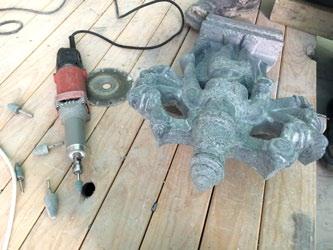
4 minute read
Vakrathunda Vinayagar temple
from 2020-07 Sydney
by Indian Link
the ninth day, in which the temple deity is taken out on the city streets. A grand chariot built in the tradition of the ancient Hindus is used for this purpose. The spectacle of it all makes it an iconic event for the area.
Today the Association has around 285 members, and thousands of devotees come for many of the main functions such as the Vinayagar Sathurthi in September/October. Numbers have grown substantially in the last five to ten years. (The 2016 Census of Population and Housing showed that the number of Hindus in Australia had increased by 60% since the previous Census in 2011.)
“The development projects at the temple have all been self-funded,” Balaa kandiah stressed. “Not a single penny has come from the government, except for the building of our multipurpose hall for which we received a $200,000 grant.”
Three temple priests conduct the worship, explaining the rituals to the younger generation in English.
Besides worship, the temple also participates in social justice programs in the mainstream including the Knox City Council’s annual festival. It boasts a 30year relationship with the Salvation Army and organises volunteer programs such as during the recent bushfires.
“As COVID struck, we could not unfortunately offer our services to the wider community as we became a building site rather than an operating temple,” Shan lamented.
Even though the third consecration planned for this year is now postponed thanks to COVID, Shan and Baala prefer to look at the bright side of it all.
“Puru has been working on the construction for 18 months since 2018, travelling frequently between India and Australia. When he arrived back in Melbourne earlier this year with 20 of his artisans for the final build, it was only a week before lockdown was announced.”
Besides the pyramid, Dravidian temple architecture requires that the building be contained within a compound wall; have a gateway in the centre of the front wall; a raised platform to enter the main door (mandapa); sculptures of fierce dvaarpaals or sentries guarding the main door, and a cupola to crown the pyramid at the very top (vimanam or shikher).
All these elements at Lord Ganesha’s newest home in Melbourne, are built in granite.
Balaa observed, “The original plan for granite was restricted to the main shrine moolasthanam, but so overwhelming was the support from our members and devotees, that we decided to go for granite for all eleven shrines in the temple. Taking into account the Australian works, which included, new roofing, new steel structure, new flooring, the various extensions both at the rear and for the Vasanthamandpam, this raised our costs from $2.5 million to $4 million.”
It also became a mammoth task for Puru.
Another of Ganesha’s miracles, no doubt. The current Temple committee comes with great experience and talent, many members currently working as civil engineers and architects, in senior management as well as early career roles. Shan and Balaa themselves retired from senior management roles in the corporate world and are now fully devoted to the temple cause.
As for the many “miracles” that have dotted the entire journey of the temple’s latest redevelopment, you’ll have to wait till the grand opening: a magnificent coffee table book has been planned to reveal all. It promises to be the ultimate tribute to Vignahaara, Remover of Obstacles.
Shan described seeing the designs on paper early on. “Each stone was numbered; its position, clearly specified, and its dimensions precisely listed. It was a massive jigsaw puzzle. I couldn’t even begin to imagine the amount of thought that went into it all!”
Balaa added, “Now that we have seen the completed structure though, we can’t tell where the stones meet, it all looks like one single piece.”
The joining process is the same as that used by our ancestors, Puru described. “The stone is hollowed out so that the load falls to the sides. The edges are made coarse, and ‘milk’ ( paal) made up of very fine cement and water is used as the binding agent.”
Puru’s drawings and designs were sent to IIT Madras where the calculations were verified and validated; the certifications provided were approved by the Australian authorities.
“Apparently the structure can withstand any earthquake,” Shan revealed.

What challenges, if any, came up in the development process?
“A major challenge was sourcing the granite,” Puru revealed. “The Indian government is restricting the amount of granite that can be exported. Our shipments were among perhaps the last few that could get out.”

Quarantine service was another road bump, Shan added. “As the carved structures were loaded on to trucks in India for the transport, heavy floods hit the area. When the shipment arrived here, it was covered in leaves and mud. It all went into quarantine, and temple volunteers had to go out to clean the entire lot. It was quite an experience, starting at 4 am each day!”
“Luckily the wood was ok,” Balaa offered. “Quarantine regulations had specified we use a particular type of wood packaging. It turned out to be the most expensive kind, so our costs went up significantly. But it was God’s wish…”
The Sri Vakrathunda Vinayagar Temple’s grand new makeover puts it in the same league as NSW’s Helensburgh Temple and Murugan Temple which were built along similar lines – with traditional artisans designing in India or coming here to create the statues and pillars. Yet it would perhaps prefer to be in the same league as Adelaide’s Ganesha Temple, which was granted heritage status in 2013.
Would the Vinayagar Temple seek heritage status too?

“It is certainly an idea we have toyed with,” Shan admitted. “But that is in the future.”
Originally scheduled for June this year, the consecration is now put off till the end of COVID restrictions.
*Contestants must be in Australia to take part










